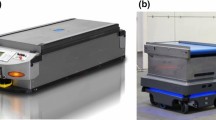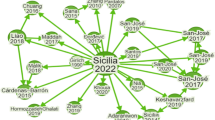Abstract
Customer order acceptance is an important process in make-to-order industries. Acceptance policies should operate such that a pre-specified delivery reliability is achieved, while maximizing resource utilization. By selecting orders with specific characteristics that maximize resource utilization, an important and often unforeseen effect occurs: the mix of orders changes such that the expected delivery reliability is no longer met. This paper investigates the selectivity of an aggregate and a detailed acceptance procedure, for batch process industries featuring complex job and resource structures. We found that the detailed policy maximizes resource utilization but underestimates the consequences on the realized makespan of significantly changing the job mix. The aggregate policy, while being selective, performs much better with respect to the delivery reliability, but achieves a lower capacity utilization. We propose a third procedure, the hybrid policy, which combines the strengths of both the detailed and aggregate acceptance procedures. Simulation experiments show that the hybrid policy successfully controls the delivery reliability, without loosing much of the beneficial effect of the selectivity on utilization.



Similar content being viewed by others
References
Bertrand JWM, Wortmann JC, Wijngaard J (1990) Production control: a structural and design oriented approach. Elsevier, Amsterdam
Carlier J (1987) Scheduling jobs with release dates and tails on identical machines to minimize the makespan. Eur J Oper Res 29:298–306
Duenyas I (1995) Single facility due date setting with multiple customer classes. Manage Sci 41:608–619
Duenyas I, Hopp WC (1995) Quoting customer lead times. Manage Sci 41:43–57
Ghosh JB (1997) Job selection in a heavily loaded shop. Comput Oper Res 24:141–145
Hahn GJ, Meeker WQ (1991) Statistical intervals. A guide for practitioners. Wiley, New York
Hollander M, Wolfe DA (1999) Nonparametric statistical methods. Wiley, New York
Ivanescu CV, Fransoo JC, Bertrand JWM (2002) Makespan estimation and order acceptance in batch process industries when processing times are uncertain. OR-Spectrum 24:467–495
Kallrath J (2003) Planning and scheduling in the process industry. In: Günther HO, van Beek P (eds) Advanced planning and scheduling solutions in process industries. Springer, Berlin Heidelberg New York
Leon VJ, Wu SD, Storer RH (1994) Robustness measures and robust scheduling for job shops. IIE Trans 26:32–43
Lewis HF, Slotnick SA (2002) Multi-period job selection: planning work loads to maximize profit. Comput Oper Res 29:1081–1098
Montgomery DC, Peck EA (1992) Introduction to linear regression analysis. Wiley, New York
Raaymakers WHM, Fransoo JC (2000) Identification of aggregate resource and job set characteristics for predicting job set makespan in batch process industries. Int J Prod Econ 68:137–149
Raaymakers WHM, Hoogeveen JA (2000) Scheduling no-wait job shops by simulated annealing. Eur J Oper Res 126:131–151
Raaymakers WHM, Bertrand JWM, Fransoo JC (2000a) The performance of workload rules for order acceptance in batch chemical manufacturing. J Intell Manuf 11:217–228
Raaymakers WHM, Bertrand JWM, Fransoo JC (2000b) Using aggregate estimation models for order acceptance in a descentralized production control for batch chemical manufacturing. IIE Trans 32:989–998
Reklaitis GV (1996) Overview of scheduling and planning of batch process operations. In: Reklaitis GV, Sunol AK, Rippin DWT, Hortacsu O (eds) Batch processing systems engineering. Springer, Berlin Heidelberg New York
Schneeweiß C (1995) Hierarchical structures in organisations: a conceptual framework. Eur J Oper Res 86:4–31
Slotnick SA, Morton TE (1996) Selecting jobs for a heavily loaded shop with lateness penalties. Comput Oper Res 23:131–140
Ten Kate HA (1994) Towards a better understanding of order acceptance. Int J Prod Econ 37:139–152
Wester FAW, Wijngaard J, Zijm WHM (1994) Order acceptance strategies in a production-to-order environment with setup times and due-dates. Int J Prod Econ 30:1313–1326
Author information
Authors and Affiliations
Corresponding author
Appendices
Appendix A: Slack factor estimation: scheduling policy
The slack factor, \(\gamma _k^\alpha\), is added in order to compensate for the effect of uncertainty in the processing times. It is determined such that a delivery performance target level equal to 100·α% is assumed, as follows. First, the relative increase of the makespan, which is a random variable, is determined for the construction data set.
Next, its empirical distribution is obtained for each Erlang shape parameter since we assume that the relative increase in the makespan is influenced only by the level of uncertainty in the processing times. The slack factor is equal to the α percentile of the empirical distribution of the relative increase variable. Table 10 gives these values for each Erlang shape parameter.
Appendix B: Interaction margin estimation
The interaction margin (Raaymakers and Fransoo 2000) is defined as the relative difference between the job set realized makespan and the Carlier lower bound :
A multiple linear regression model is used to predict the average interaction margin for a given job set. The following aggregate job set characteristics, as well as interactions between these variables, represent the regressors in our model:
-
1.
Average number of processing steps (μ s ):
$$\mu _{s} = \frac{1}{{n_{{jobs}} }}{\sum\limits_{j = 1}^{n_{{jobs}} } {s_{j} } }$$(14) -
2.
Squared coefficient of variation of the expected processing times (scv E[p]):
$$scv^{2}_{{E{\left[ p \right]}}} = \frac{{\sigma ^{2}_{{E{\left[ p \right]}}} }}{{\mu ^{2}_{{E{\left[ p \right]}}} }}$$(15)where
$$\sigma ^{2}_{{E{\left[ p \right]}}} = \frac{1}{{S - 1}}{\sum\limits_{j = 1}^{n_{{jobs}} } {{\sum\limits_{i = 1}^{s_{j} } {{\left( {E_{{{\left[ {p_{{ij}} } \right]}}} - \mu _{{E{\left[ p \right]}}} } \right)}} }^{2} ,} }$$(16)$$S = {\sum\limits_{j = 1}^{n_{{jobs}} } {s_{j} } }$$(17)and
$$\mu _{{E{\left[ p \right]}}} = \frac{1}{S}{\sum\limits_{j = 1}^{n_{{jobs}} } {{\sum\limits_{i = 1}^{s_{j} } {E_{{{\left[ {pi_{j} } \right]}}} } }} }$$(18) -
3.
Workload balance (ρ max), represented by the maximum utilization if the makespan were equal to the lower bound:
$$\rho _{{\max }} = \frac{{\overline{L} }}{{LB}}$$(19)where
$$\overline{L} = \frac{1}{N}{\sum\limits_{m = 1}^M {{\sum\limits_{n = 1}^{n_{m} } {L_{n} } }} }$$(20)$$N = {\sum\limits_{m = 1}^M {n_{m} } }$$with M denoting the number of resource types and n m the number of resources of resource type m.
-
4.
Squared coefficient of variation of the effective processing time (scv p ):
$$cv^{2}_{p} = \frac{{{\left( {b - a} \right)}^{2} }}{{3 \cdot {\left( {b + a} \right)}^{2} }} + \frac{{4 \cdot {\left( {b^{2} + a \cdot b + a^{2} } \right)}}}{{3 \cdot k \cdot {\left( {b + a} \right)}^{2} }}$$(21)where the expected processing times are uniformly distributed on [a,b] and k is the shape parameter of the Erlang distribution.
For details regarding these characteristics we refer to Raaymakers and Fransoo (2000).
Stepwise regression is used to develop alternative models. We used the SPSS software package. These models were examined for multicollinearity, because a high degree of multicollinearity makes the results not generalizable as the parameter estimates in the models may not be stable. Among the models with the lowest degree of multicollinearity, we selected the model with the highest adjusted R 2 value. A residual analysis is performed to test the adequacy of this model. Because heteroscedasticity was proved to be present, a natural logarithm transformation of the response variable has been applied. Diagnostic checks on the subsequent model confirmed the appropriateness of this transformation. Eq. (22) gives the regression equation for the subsequent model.
75% of the variability in the new response variable, the transformed interaction margin, is explained by this model and the standard error of the estimate (\(\widehat{\sigma }\)) is equal to 0.11, indicating a good fit to the data.
The predictive performance of this model is further evaluated on the testing data set. The mean estimation error is 0.01 and the standard deviation of the estimation error is 0.12. Thus, we may conclude that the model produces approximately unbiased estimates.
Furthermore, as described in Section 3.2, an upper 100·α% prediction bound for the interaction margin is used to determine estimates of the realized makespan. Montgomery and Peck (1992) show how to compute a prediction interval for multiple linear regression analysis and Hahn and Meeker (1991) discuss the relationship between one-sided prediction bounds and two-sided prediction intervals. We give here the formula for the upper 100·α% prediction bound and we refer to these textbooks for more details:
where
- \(t_{{\alpha ,df}} \) :
-
the required critical value of Student's t distribution with df degrees of freedom;
- X :
-
the n×(k+1) matrix of the levels of the regressor variables;
- \({\mathbf{x}}_{*} \) :
-
the row vector identifying the coordinates at which the prediction is to be made;
- n :
-
the number of observations;
- k :
-
the number of regressors variables.
Note that if the sample size (i.e. n) is large, the term \({\mathbf{x}}^{T}_{{_{*} }} {\left( {X^{T} X} \right)}^{{ - 1}} {\mathbf{x}}_{*} \) is negligible.
Appendix C: Slack factor estimation: hybrid policy
The relative increase of the makespan (defined in Eq. (12)) due to the stochastic processing times may depend on specific job set characteristics. For example, a job set containing jobs with a high number of processing steps and low overlap may experience a larger makespan increase than job sets containing jobs with a small number of processing steps and high overlap. We statistically investigate here the relationship between the makespan increase and a number of job set characteristics, and we develop a multiple regression model to estimate the slack fraction needed to compensate in the order acceptance phase for this makespan increase.
The same six job set characteristics that proved to have a significant contribution to explaining the variation in the interaction margin are also investigated for the relative makespan increase. Regression models are determined following the same procedure as in Appendix B. We obtained the following regression equation:
The adjusted R 2 of this model is 0.66 and the standard error of the estimate (\(\widehat{\sigma }\)) is equal to 0.23. These two measures indicate that the estimated regression equation fits reasonably good the means of the transformed data. This model is further validated on the testing data set. The mean estimation error (ME) is 0.01, thus the model seems to produce approximately unbiased predictions. The standard deviation of the estimation error (SDE) is equal to 0.23
The slack factor is determined such that a delivery performance target level equal to 100·α% is assumed. Thus, similar to the interaction margin estimation, the slack factor is made equal to the 100·α% prediction bound of the response variable:
Rights and permissions
About this article
Cite this article
Ivănescu, V.C., Fransoo, J.C. & Bertrand, J.W.M. A hybrid policy for order acceptance in batch process industries. OR Spectrum 28, 199–222 (2006). https://doi.org/10.1007/s00291-005-0015-2
Published:
Issue Date:
DOI: https://doi.org/10.1007/s00291-005-0015-2




